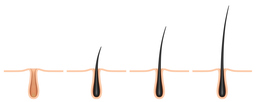BpV(pic) and Hair Growth
TECHNOLOGY NUMBER: 2021-308

OVERVIEW
A topically applied molecule that can promote hair growth or regrowth- Causes an increased proliferation of follicle stem cells
- May diminish hair loss from any of the common causes of alopecia
BACKGROUND
Hair loss, also known as alopecia, is a condition that affects roughly 85% of men and 50% of women by the time they reach their sixth decade. The two main causes for hair loss are androgenic alopecia (AGA) and alopecia areata (AA). AGA is the biggest contributor to hair loss and results in a receding hair line or baldness in males and overall thinning of the hair in women. The mechanism by which AGA causes hair loss in men is hair follicle shrinkage which limits new hair growth, while the processes causing thinning of hair in women is less understood. AA, on the other hand, is an autoimmune disease that affects about 2% of the US population and which is associated hair loss due to inappropriate attacks of the hair follicles by T cells. Hair loss can also result from other medical conditions such as an adverse effect of common cancer treatments, aging, and environmental, and genetic factors.
The existing therapies for alopecia are limited and fairly labor intensive. Currently there are only two FDA approved drugs to treat alopecia, both of which come with potentially severe side effects or lackluster results. These therapies must also be used continuously, or the hair loss will resume. Alternatively, hair transplants can be performed by removing hair follicles from an area with dense hair growth and implanting the follicles into tiny slits on the affected area of the head. While many patients experience thicker-looking hair following the transplant, it is not uncommon for patients to still experience continued hair thinning which could require additional follow-up transplants. A need exists for therapies to not only prevent further hair loss, but to also promote new, sustained growth of hair.
INNOVATION
Researchers at the University of Michigan have discovered that the topical use of a molecule called Dipotassium Bisperoxovanadium dihydrate bpV(pic) can induce hair growth. The molecule is applied in a topical formulation that directs hair growth, or regrowth, to specific sites on the skin. The bpV(pic) molecule inhibits phosphotyrosine phosphatase (PTP) and phosphatase and tensin homolog (PTEN), proteins that play a critical role in cell growth, proliferation, and differentiation. This approach was found to have a positive effect on hair growth in models of both young and older mice. Microscopic evaluation of the effects of bpV(pic) showed an increased proliferation of skin cells and elevated numbers of follicle stem cells at the treated sites. The potential applications of this drug are wide, with reasonable hopes for hair growth resulting from any of the known causes of alopecia.